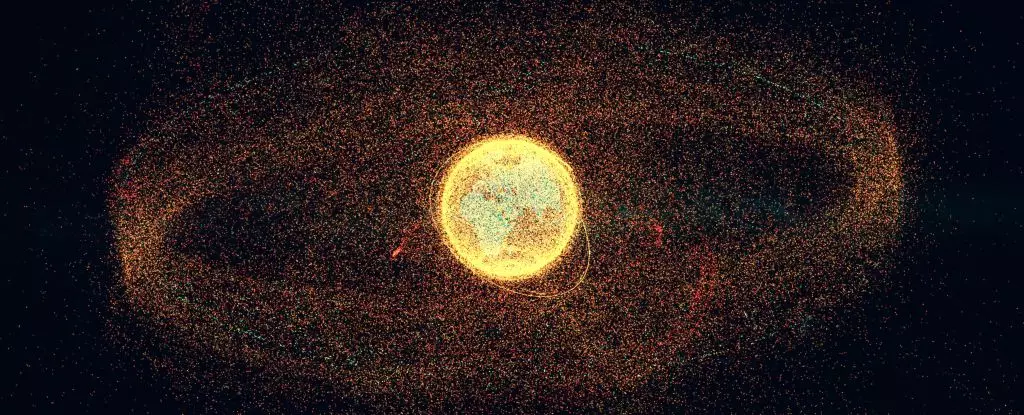As humanity advances into the cosmos, one pressing concern looms larger than any mission to Mars or exploration of distant exoplanets: the burgeoning problem of space debris. The European Space Agency (ESA) recently issued a stark warning in its annual Space Environment Report, indicating that the accumulation of debris in Earth’s orbit is not just a gradual problem; it’s accelerating with terrifying speed. With more satellites being launched than ever, the cosmos is becoming increasingly cluttered with remnants of defunct satellites, spent rocket stages, and fragments from previous collisions. If this trajectory continues unchecked, we risk encountering a catastrophic situation known as the Kessler syndrome, where a single collision could set off a chain reaction, leading to an exponential increase in space junk.
It’s not merely a theoretical risk anymore. While we may not have reached a breaking point yet, experts agree that the current pace of launches is unsustainable. Even more alarming is the acknowledgment that the debris problem will worsen even if we halt all new launches today. This is due to the myriad of fragmentation events that have occurred, where the remnants from failed missions and other instances can proliferate far more quickly than they can safely re-enter Earth’s atmosphere.
The Disquieting Statistics
To grasp the scope of this challenge, one must delve into the numbers. Currently, monitoring programs are keeping track of around 40,000 objects orbiting our planet, with a meager fraction—approximately 11,000—being operational satellites. The figures presented by the ESA highlight a startling reality; there are an estimated 54,000 pieces of debris larger than 10 centimeters, and a staggering 1.2 million fragments between 1 and 10 centimeters, along with a whirlwind of 130 million tiny pieces measuring between 1 millimeter and 1 centimeter. Each of these items poses a risk to our operational satellites, the International Space Station (ISS), and other vital assets. Notably, tiny debris can cause harrowing damage, given their high velocity.
Adding to this conundrum are “non-collisional fragmentation events,” which unexpectedly generate significant amounts of additional debris. With 2024 marking a turning point, it was revealed that these incidents had become the predominant source of new debris, accounting for the creation of over 2,600 new fragments in a single year. The uncontrolled nature of these events complicates our attempts to manage the cosmos, as we cannot guarantee that these bits will follow a path that leads them back into the atmosphere safely.
Progress and Challenges in Mitigation
Despite the perilous outlook, there are glimmers of hope. The number of controlled atmospheric entries of retired satellites and rocket stages has risen, indicating that disposal strategies are making a positive impact. The ESA has reported that compliance with guidelines mandating the deorbiting of rocket stages within 25 years has improved significantly, with about 90% of these bodies now adhering to this standard. An impressive majority of them are now entering the atmosphere in a controlled manner, which mitigates the risk of creating additional debris.
In addition to better compliance, there are initiatives aimed at cleaning up space debris actively. These are not mere theoretical concepts; they require international collaboration and a concerted effort to innovate and implement solutions. From specialized satellites designed to capture and deorbit old spacecraft to potential technologies that can remove smaller pieces of debris, the vision for a cleaner orbital environment is in the works. However, realizing this vision demands global unity, resources, and shared responsibility from countries that have access to space.
Reimagining Our Relationship with Space
Addressing the space debris crisis requires a profound shift in how we perceive and manage our ventures into the cosmos. As we traverse further into space, we must prioritize sustainable practices that not only facilitate exploration but also safeguard the orbital environment for future generations. The tantalizing promise of space should not come at the cost of reckless abandonment that could render vital orbits unusable.
Every launch that takes place must be weighed against its potential impact on the ecosystem of space. We need to embed sustainability into the very fabric of our exploration strategies—a commitment to responsible design, operation, and end-of-life management of satellites and rockets. Such cultural transformations are critical if we hope to prevent turning our journey into the stars into a perilous game of space dodgeball.
The challenge of space debris is daunting, but it is not insurmountable. By maintaining a focus on proactive solutions and fostering collaboration among nations, we can ensure that our aspirations in space do not lead to a fractured, hazardous orbit that jeopardizes not only our current capabilities but the future of humanity’s reach into the final frontier.


Leave a Reply